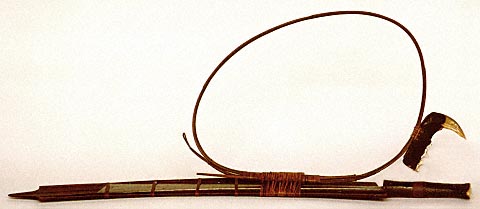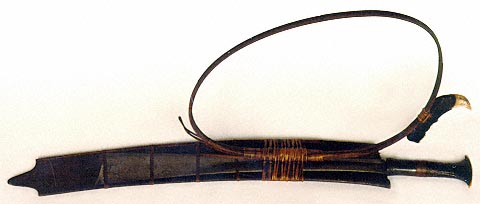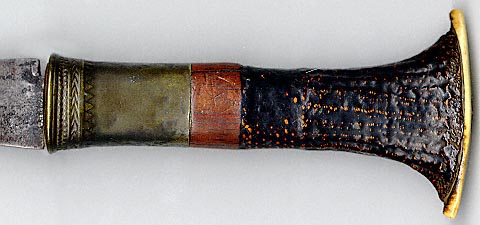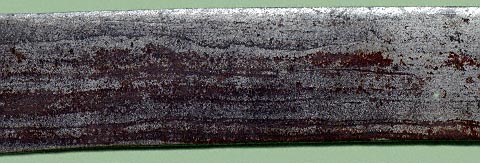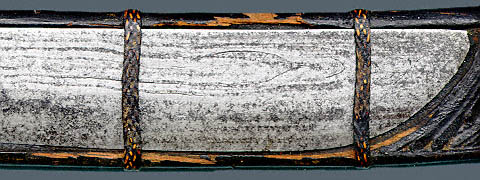Sword-daos of the Hill Tribes of Assam and Nagaland (northeastern India) and of the Kachin Peoples (northern Burma (Myanmar))
Example 1. Sword-dao, late 19th to early 20th Century, this particular example reputedly from Nagaland, but extremely similar to an example described as being of the Kachin type in Rawson (plate 37) and to an example in the Pitt-Rivers Museum in Oxford, England which is also labeled as being of the Kachin type. The end of the hilt is flared out and capped by a plate of ivory or bone. The grip of the handle is wrapped with basketry painted black towards the cap and a bronze ferrule covers the hilt towards the blade, such that only a small band of the underlying wood is exposed. The single cutting edge, oriented upward in the photographs above, is almost straight although a minimal convex curve may be discerned upon close examination. The face of the blade shown has an indistinct bevel, occupying about two-fifths of the blade's width, where the blade thins to form the edge. The opposite blade face is relatively flat. The scabbard is of carved wood, centrally hollowed out on one face for the blade. While the lip facing the spine of the blade is integral, the lip towards the cutting edge appears to be an old replacement, possibly of bamboo. Rattan straps hold the blade within its shallow. A rattan belt hoop is attached to the scabbard. A half of a tiger mandible (jawbone) is attached to this belt. The lower picture is inverted (upside-down) as to how this sword would have been worn. Overall length (including scabbard): 84.6 cm. (33.3 inches); blade length: 53 cm. (20.8 inches).
The phrase sword-dao is used herein, after the practice of Rawson (1968), to differentiate the subgroup of weapons considered on this page from the general purpose dao which, although of many forms, usually tends to be a broad, thin bladed axe somewhat like a fascine knife, which was used not only in war but as the Naga's primary tool. Variants of the sword-dao were found among the hill tribes occupying the foothills of the eastern Himalayas in what now includes Assam and Nagaland in northeastern India and among the Kachin of northern Burma (Myanmar). While these short swords were likely worn in many ways, some retain a hoop-like rattan belt fastened to the scabbard, such as that illustrated as the first example. In this case the belt appears to have been intended for the waist with the sword-dao worn diagonally at the front, edge up, with the hilt higher than the tip in ready position for the right hand.
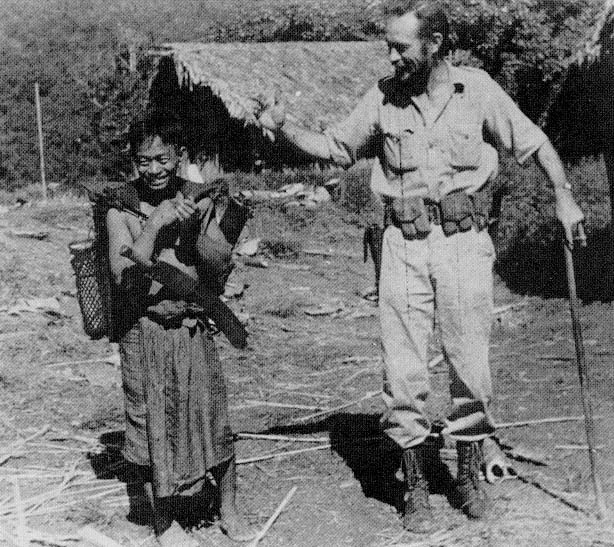 |
|
|
Example 2. Sword-dao, early 20th Century. The simple wood handle is wrapped with basketry towards the blade. Differential corrosion has disclosed the blade to have a piled structure. The single edged blade, with a slightly convex curved edge, is illustrated edge up. The flat face of the blade is shown in the full length view and in the blade detail photograph; the side of the blade shown in the detail photograph of the handle has an indistinct bevel, occupying about two-fifths of the blade's width, where the blade thins to form the edge. Overall length: 66.3 cm. (26 inches); blade length: 50.7 cm. (20 inches).
The blades tend to be narrowest a short distance from the guardless hilt and widest at the far end. This does not make the sword-dao as blade heavy as the pictures may suggest, as, through thickness manipulation, the smiths have set the balance points for each of the first two examples just shy of forty percent of blade length. Much emphasis is found in the literature that, owing to blade cross-sectional geometry, the sword-dao, like the mandau, has a "chisel edge" that is only suited for a stroke from above on the cutter's right to below on the cutter's left. Like so much of weapons lore, this limitation is likely seriously overstated. While blades of sword-daos are, indeed, generally relatively flat on the side to the holder's left with the blade oriented edge-down, this flatness should not be overemphasized, as, at least in all three of the examples illustrated here, the "flat" face tends to round subtly toward the edge as the edge is approached. The opposite blade face in these examples shows a definite, though somewhat indistinct, bevel usually about two-fifths of the blade width back from the edge, which is where the blade reaches its maximum thickness. From this bevel there is also a subtle thinning approaching a generally squared spine. Classically the end is squared off, often with somewhat of a concave curve, however some examples, such as the third one, below, will have a true tip.
Rawson describes the area of Assam where these swords were used as "metal-starved" and indicated that iron would have been obtained through trade with Tibet, Burma and the plains (p. 59). The blade of the third example (below) shows a piled construction suggesting a composition of nested "hairpin" rods, exactly paralleling that seen in many Tibetan swords. Rawson suggests that these blades may have been made in Tibet or made from Tibetan rods in imitation of Tibetan style (page 63).

Example 3. Slightly curved sword-dao and its open-faced, carved wooden scabbard, late 19th to early 20th Century. Though of correct form, the hilt appears to have undergone significant restoration. The blade is illustrated edge down in the full length view which is of the beveled side of the blade. The opposite blade face is relatively flat. Close-ups of the tip of the blade disclose the manner of piled construction of the spine portion of the blade by means of a nested set of rods turned back upon themselves like hairpins, exactly as is seen in swords from adjacent Tibet. The scabbard is carved with a number of figures. Overall length (including scabbard): 69.5 cm. (27.3 inches); blade length: 48 cm. (18.9 inches).
The open-faced scabbards are composed of a long, gently curving flat piece of carved wood which is hollowed out on one side to receive the blade, which is held in place by a series of rattan bands.
The Pitt-Rivers Museum on the campus of Oxford University in Oxford, England has and displays a substantial collection of Naga weapons and artifacts.
